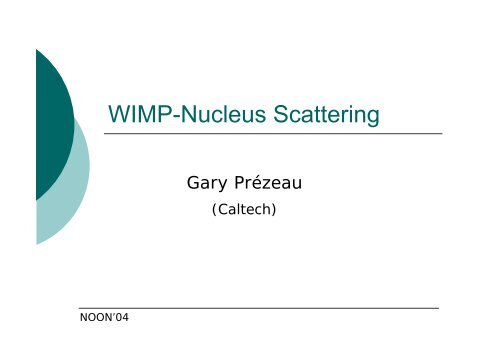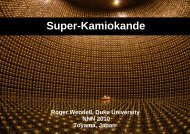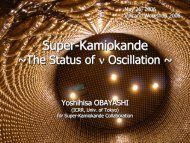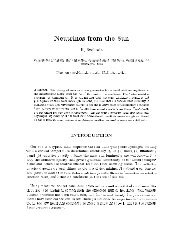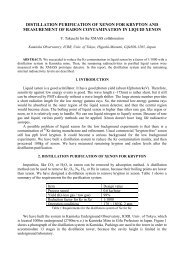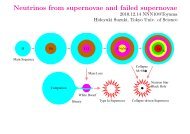WIMP-Nucleus Scattering
WIMP-Nucleus Scattering
WIMP-Nucleus Scattering
You also want an ePaper? Increase the reach of your titles
YUMPU automatically turns print PDFs into web optimized ePapers that Google loves.
<strong>WIMP</strong>-<strong>Nucleus</strong> <strong>Scattering</strong><br />
Gary Prézeau<br />
(Caltech)<br />
NOON’04
<strong>WIMP</strong>-<strong>Nucleus</strong> <strong>Scattering</strong><br />
◦ The nature of dark matter remains a<br />
standing problem in cosmology and<br />
particle physics.<br />
◦ It’s relic abundance can be used to<br />
determine the scale of its interactions.<br />
NOON’04
<strong>WIMP</strong>-<strong>Nucleus</strong> <strong>Scattering</strong><br />
Ω χ ~3x10 -27 cm 3 s -1 /~10 -1<br />
~10 -26 cm 3 s -1<br />
About the weak scale<br />
NOON’04
<strong>WIMP</strong>-<strong>Nucleus</strong> <strong>Scattering</strong><br />
◦ Thus, a particle that interacts<br />
weakly looks like a promising dark<br />
matter candidate (e.g. neutralinos,<br />
KK modes, sterile neutrinos).<br />
◦ There is also a chance of detecting<br />
it directly by looking at the recoil of<br />
a nucleus that scattered a <strong>WIMP</strong>.<br />
NOON’04
<strong>WIMP</strong>-<strong>Nucleus</strong> <strong>Scattering</strong><br />
◦ Can consider the <strong>WIMP</strong> in a<br />
particular model, such as MSSM<br />
◦ In that case, you know all the<br />
couplings and the calculation of<br />
amplitudes (like scattering) is<br />
straightforward<br />
NOON’04
<strong>WIMP</strong>-<strong>Nucleus</strong> <strong>Scattering</strong><br />
◦ In particular, couplings of<br />
neutralinos to quarks and gluons<br />
can be expressed in terms of the<br />
MSSM parameters<br />
◦ From there, spin-dependent (SD)<br />
and spin-independent (SI) <strong>WIMP</strong>parton<br />
interactions can be derived.<br />
NOON’04
<strong>WIMP</strong>-<strong>Nucleus</strong> <strong>Scattering</strong><br />
At tree level, the following diagrams contribute to<br />
the effective SI neutralino-quark coupling:<br />
NOON’04
<strong>WIMP</strong>-<strong>Nucleus</strong> <strong>Scattering</strong><br />
SI neutralino-quark<br />
effective coupling<br />
after expanding in<br />
inverse powers of the<br />
heavy masses:<br />
C 1 qqχχ<br />
NOON’04
<strong>WIMP</strong>-<strong>Nucleus</strong> <strong>Scattering</strong><br />
From M. Drees and M. Nojiri Phys. Rev. D<br />
47, 4226–4232 (1993) the following<br />
diagrams contribute to the SI neutralinogluon<br />
coupling:<br />
NOON’04
<strong>WIMP</strong>-<strong>Nucleus</strong> <strong>Scattering</strong><br />
SI neutralino-gluon effective<br />
coupling (after expansion):<br />
C 2 qqG µν,a G µν<br />
a<br />
NOON’04
<strong>WIMP</strong>-<strong>Nucleus</strong> <strong>Scattering</strong><br />
• From these neutralino-parton<br />
interactions, you must now<br />
construct the effective neutralinohadron<br />
interactions. Typically, this<br />
means the neutralino-nucleon<br />
vertex:<br />
χ<br />
χ<br />
N<br />
N<br />
NOON’04
<strong>WIMP</strong>-<strong>Nucleus</strong> <strong>Scattering</strong><br />
◦ Traditionally, the NNχχ vertex is the<br />
only one considered, but there<br />
could be other hadrons that<br />
contribute to the SI neutralinonucleus<br />
cross-section.<br />
◦ What about: ππχχ<br />
NOON’04
<strong>WIMP</strong>-<strong>Nucleus</strong> <strong>Scattering</strong><br />
◦ You need some way to estimate the<br />
potential size of any new<br />
contributions relative to NNχχ<br />
◦ Effective Field Theory (EFT) can<br />
help.<br />
◦ More general than MSSM.<br />
NOON’04
<strong>WIMP</strong>-<strong>Nucleus</strong> <strong>Scattering</strong><br />
<br />
◦ Use symmetry properties to relate underlying<br />
model to low-energy Lagrangian.<br />
L(q,χ)<br />
SU(2) L SU(2) R , CP, P<br />
L(N,π,χ)<br />
NOON’04
<strong>WIMP</strong>-<strong>Nucleus</strong> <strong>Scattering</strong><br />
◦ No specific model required. Can write<br />
most general Lagrangian.<br />
◦ Instead of MSSM neutralino, can use a<br />
general <strong>WIMP</strong> candidate with arbitrary<br />
quantum numbers.<br />
◦ <strong>WIMP</strong>-quark interactions are set by a<br />
heavy scale > 100GeV<br />
NOON’04
<strong>WIMP</strong>-<strong>Nucleus</strong> <strong>Scattering</strong><br />
◦ The series of possible quark operators<br />
is truncated at leading order (LO) in<br />
inverse powers of the heavy scale Λ.<br />
◦ The series of corresponding hadron<br />
operators is truncated at some order<br />
in p/Λ h where p~m π and Λ h ~1GeV<br />
(Chiral Perturbation Theory).<br />
NOON’04
<strong>WIMP</strong>-<strong>Nucleus</strong> <strong>Scattering</strong><br />
◦ EFT can be used on a wide range of<br />
physical problems where the<br />
fundamental interactions are unknown,<br />
for example, 0νββ and <strong>WIMP</strong>-nucleus<br />
scattering.<br />
NOON’04
<strong>WIMP</strong>-<strong>Nucleus</strong> <strong>Scattering</strong><br />
◦ For 0νββ consider (GP, P. Vogel, M. Ramsey-<br />
Musolf Phys.Rev.D68:034016,2003)<br />
NOON’04
<strong>WIMP</strong>-<strong>Nucleus</strong> <strong>Scattering</strong><br />
◦ Let us look at the application of EFT to <strong>WIMP</strong>nucleus<br />
scattering in more detail (GP, A.<br />
Kurylov, M. Kamionkowski, and P. Vogel Phys.<br />
Rev. Lett. 91:231301,2003) :<br />
NOON’04
<strong>WIMP</strong>-<strong>Nucleus</strong> <strong>Scattering</strong><br />
◦ This Lagrangian will give rise to ππχχ,<br />
πN 2 χχ, N 2 χχ vertices that will contribute<br />
to the scattering amplitude:<br />
NOON’04<br />
New
<strong>WIMP</strong>-<strong>Nucleus</strong> <strong>Scattering</strong><br />
◦ The new diagrams generated by<br />
these new interactions are:<br />
Sub-leading<br />
NOON’04
<strong>WIMP</strong>-<strong>Nucleus</strong> <strong>Scattering</strong><br />
◦ As an explicit example, consider the ππχχ<br />
Lagrangian to NLO (one derivative):<br />
NOON’04
<strong>WIMP</strong>-<strong>Nucleus</strong> <strong>Scattering</strong><br />
◦ Expressions for the coefficients in terms of<br />
the parameters appearing in the quarkneutralino<br />
Lagrangian can be derived using<br />
PCAC and CVC theorems:<br />
NOON’04
<strong>WIMP</strong>-<strong>Nucleus</strong> <strong>Scattering</strong><br />
◦ Leading to:<br />
NOON’04
<strong>WIMP</strong>-<strong>Nucleus</strong> <strong>Scattering</strong><br />
To leading order in p/Λ h , you can generally neglect<br />
compared to:<br />
NOON’04
<strong>WIMP</strong>-<strong>Nucleus</strong> <strong>Scattering</strong><br />
◦ So far, we have not assumed anything about<br />
the underlying model. In MSSM however<br />
X<br />
X<br />
X<br />
X<br />
NOON’04
<strong>WIMP</strong>-<strong>Nucleus</strong> <strong>Scattering</strong><br />
◦ So far, we have not assumed anything about<br />
the underlying model. In MSSM however<br />
X<br />
]<br />
SI interaction<br />
Suppressed by p/Λ h<br />
SD interaction<br />
NOON’04
<strong>WIMP</strong>-<strong>Nucleus</strong> <strong>Scattering</strong><br />
In MSSM we have<br />
Leading to the SI operators:<br />
NOON’04
<strong>WIMP</strong>-<strong>Nucleus</strong> <strong>Scattering</strong><br />
◦ Thus, the only diagrams that contribute to<br />
the SI amplitude to LO are:<br />
+<br />
N<br />
χ<br />
χ<br />
N<br />
NOON’04
<strong>WIMP</strong>-<strong>Nucleus</strong> <strong>Scattering</strong><br />
◦ The relative size of these two diagrams can<br />
be expressed as a ratio:<br />
NOON’04<br />
where = F(A) ~ A<br />
and r depends on the MSSM parameters and<br />
depends on the two-nucleon matrix<br />
element.
<strong>WIMP</strong>-<strong>Nucleus</strong> <strong>Scattering</strong><br />
◦ The pion exchange diagram has a non-trivial<br />
dependence on nuclear structure. It could<br />
change from nucleus to nucleus.<br />
◦ Opposite signs between the two diagrams<br />
could have a significant effect on detection<br />
rates from different target nuclei because of<br />
cancellations that would occur for one<br />
nucleus and not another.<br />
NOON’04
<strong>WIMP</strong>-<strong>Nucleus</strong> <strong>Scattering</strong><br />
Summary:<br />
◦ Effective field theory is a powerful tool when<br />
estimating the relative size of <strong>WIMP</strong>-hadron<br />
contributions to scattering amplitudes for arbitrary<br />
DM models.<br />
◦ Generally, one can obtain large contributions from<br />
pion-exchange to SI amplitude.<br />
◦ Detection rates could depend non-trivially on<br />
target nuclei.<br />
NOON’04


